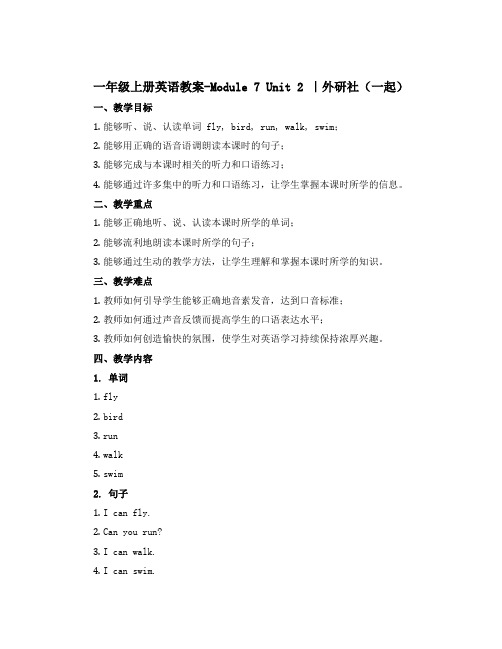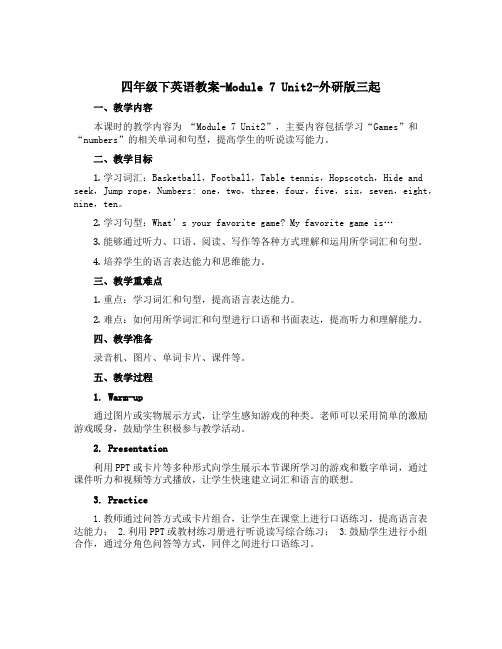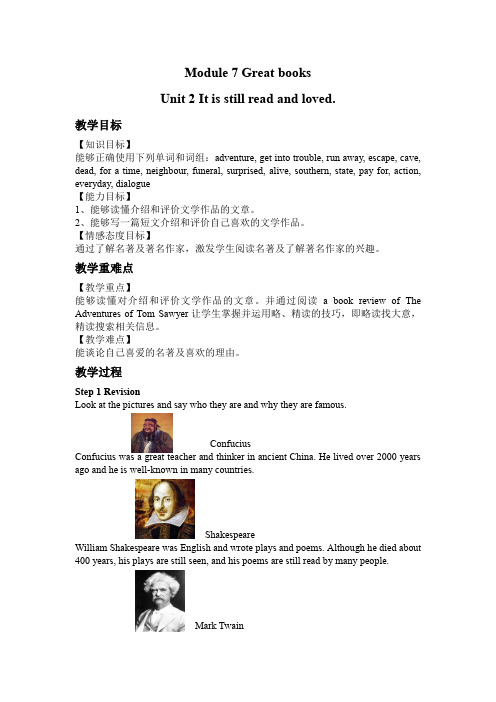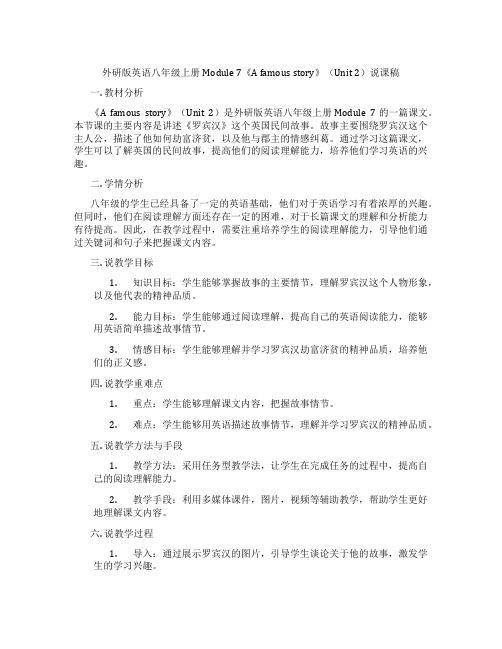【教学设计】Module 7 Unit 2(外研)
一年级上册英语教案-Module 7 Unit 2 |外研社(一起)

一年级上册英语教案-Module 7 Unit 2 |外研社(一起)一、教学目标1.能够听、说、认读单词 fly, bird, run, walk, swim;2.能够用正确的语音语调朗读本课时的句子;3.能够完成与本课时相关的听力和口语练习;4.能够通过许多集中的听力和口语练习,让学生掌握本课时所学的信息。
二、教学重点1.能够正确地听、说、认读本课时所学的单词;2.能够流利地朗读本课时所学的句子;3.能够通过生动的教学方法,让学生理解和掌握本课时所学的知识。
三、教学难点1.教师如何引导学生能够正确地音素发音,达到口音标准;2.教师如何通过声音反馈而提高学生的口语表达水平;3.教师如何创造愉快的氛围,使学生对英语学习持续保持浓厚兴趣。
四、教学内容1. 单词1.fly2.bird3.run4.walk5.swim2. 句子1.I can fly.2.Can you run?3.I can walk.4.I can swim.3. 语言运用1.单词和句子的正常语音语调;2.能够根据句子的意思进行正确的语音语调调整;3.语音知识的应用。
五、教学准备1.录音机和磁带 (或者其他音频播放设备)2.学生课本及作业本3.图片、漫画和教学PPT4.老师自创的口语练习活动六、教学方法1.欣赏图片与文字,引发学生学习兴趣;2.声控教学,启发学生口语表达能力;3.分组合作,强调团队合作精神;4.观赏视频,帮助学生理解内容。
七、教学过程1. Warm-up1.复习上一课时所学的内容;2.通过课前的简短游戏,激发学生的学习兴趣。
2. Presentation1.展示图片和中英文单词,让学生完成对英语单词的初步学习;2.听录音带,让学生边听边模仿,学习正确的语音语调。
3. Practice1.分组分角色练习四则运算;2.提供与本课时一致的听力和口语练习;3.完成学生课本和作业本上的练习。
4. Summary1.简单地回顾所学知识;2.提醒学生注意重点难点。
Module 7 Unit 2 Pandas love bamboo第二课时(教学设计)外研版(三起

Unit 2 Pandas love bamboo.第二课时课时内容4.Listen and learn to say.,5.Listen and say.,6.Listen and say.&7.Write and say.课时分析本单元是对上节课中学习过的英语中一般现在时句型的扩展和练习,学生可以运用所学语言讨论动物习性这一真实语言情景,将语言变得生活化、情境化,从而掌握一般现在时的各种句式。
众所周知,英语一般现在时在小学英语中出现的频率是比较高的,所以在学生掌握了此种时态后,可以在日常生活中自由的运用更多的句子,同时也是学习更多种时态的基础。
本课主题是Pandas love bamboo。
主要内容是通过课文中大量图片的展示,让学生说一说这些动物喜欢干什么。
本课重点在于让学生通过介绍动物或自己与他人的喜好来掌握句型。
外研版六年级上册module 7unit 2第二课时包含四部分内容,Listen and learn to say.该版本是对句子的语调的把握;Listen and say. Then chant.该板块旨在通过听、说和唱的方式来学习该部分内容,我们一听一说一唱的方式调动孩子们的积极性和对英语的热情。
Listen and say.该部分是看图读句子然后理解活动的要求,我们要一个学生先想好一种动物,另一个人通过提问猜测的形式,要充分运用课文中提供的句型进行问答;Write and say.我们是通过阅读题干,理解活动要求,要求两人一组开展有关动物生活习性的知识竞赛,一起比试下看谁的知识最丰富。
课时目标(1)学生通过观看图片,了解不同的动物的喜好。
(2)学生通过了解不同动物的喜好,建立对动物们的爱心与情感,从小就爱惜小动物,因为他们也有生命,有自己的爱好。
课时重难点1.重点能够比较熟练地运用like / love句型进行描述。
2.难点能够运用句型描述不同动物的喜好。
教学准备多媒体课件、图片、听磁带、情景教学法、角色扮演法教学过程Step1. Warm up1.Greetings2.Free talk T: do you like music / meat…?S: Yes, I do. / No, I don’t.3.Work in pairs 看哪组说的多,提出表扬。
四年级下英语教案-Module 7 Unit2-外研版三起

四年级下英语教案-Module 7 Unit2-外研版三起一、教学内容本课时的教学内容为“Module 7 Unit2”,主要内容包括学习“Games”和“numbers”的相关单词和句型,提高学生的听说读写能力。
二、教学目标1.学习词汇:Basketball,Football,Table tennis,Hopscotch,Hide and seek,Jump rope,Numbers: one,two,three,four,five,six,seven,eight,nine,ten。
2.学习句型:What’s your favorite game? My favorite game is…3.能够通过听力、口语、阅读、写作等各种方式理解和运用所学词汇和句型。
4.培养学生的语言表达能力和思维能力。
三、教学重难点1.重点:学习词汇和句型,提高语言表达能力。
2.难点:如何用所学词汇和句型进行口语和书面表达,提高听力和理解能力。
四、教学准备录音机、图片、单词卡片、课件等。
五、教学过程1. Warm-up通过图片或实物展示方式,让学生感知游戏的种类。
老师可以采用简单的激励游戏暖身,鼓励学生积极参与教学活动。
2. Presentation利用PPT或卡片等多种形式向学生展示本节课所学习的游戏和数字单词,通过课件听力和视频等方式播放,让学生快速建立词汇和语言的联想。
3. Practice1.教师通过问答方式或卡片组合,让学生在课堂上进行口语练习,提高语言表达能力;2.利用PPT或教材练习册进行听说读写综合练习;3.鼓励学生进行小组合作,通过分角色问答等方式,同伴之间进行口语练习。
4. Production让学生根据已学内容完成一些简单的任务,如记录自己喜欢或不喜欢的游戏,并进行简单的书面表达;或通过拼图、制作课件等方式进行小组作业等,提高学生的创新能力和动手能力。
5. Extension对课堂知识进行延伸拓展,为学生提供更多的语言输入壮大其语言环境。
【外研版九年级英语上册】Module 7 Unit 2 教案

Module 7 Great booksUnit 2 It is still read and loved.教学目标【知识目标】能够正确使用下列单词和词组:adventure, get into trouble, run away, escape, cave, dead, for a time, neighbour, funeral, surprised, alive, southern, state, pay for, action, everyday, dialogue【能力目标】1、能够读懂介绍和评价文学作品的文章。
2、能够写一篇短文介绍和评价自己喜欢的文学作品。
【情感态度目标】通过了解名著及著名作家,激发学生阅读名著及了解著名作家的兴趣。
教学重难点【教学重点】能够读懂对介绍和评价文学作品的文章。
并通过阅读 a book review of The Adventures of Tom Sawyer让学生掌握并运用略、精读的技巧,即略读找大意,精读搜索相关信息。
【教学难点】能谈论自己喜爱的名著及喜欢的理由。
教学过程Step 1 RevisionLook at the pictures and say who they are and why they are famous.ConfuciusConfucius was a great teacher and thinker in ancient China. He lived over 2000 years ago and he is well-known in many countries.ShakespeareWilliam Shakespeare was English and wrote plays and poems. Although he died about 400 years, his plays are still seen, and his poems are still read by many people.Mark TwainMark Twain was an American writer. His stories are set in the south of the US over 100 years ago, and readers still enjoy them very much.Step 2 Scanning(略读) 小组讨论,最后得出答案。
外研版英语八年级上册Module7《Afamousstory》(Unit2)说课稿

外研版英语八年级上册Module 7《A famous story》(Unit 2)说课稿一. 教材分析《A famous story》(Unit 2)是外研版英语八年级上册Module 7的一篇课文。
本节课的主要内容是讲述《罗宾汉》这个英国民间故事。
故事主要围绕罗宾汉这个主人公,描述了他如何劫富济贫,以及他与郡主的情感纠葛。
通过学习这篇课文,学生可以了解英国的民间故事,提高他们的阅读理解能力,培养他们学习英语的兴趣。
二. 学情分析八年级的学生已经具备了一定的英语基础,他们对于英语学习有着浓厚的兴趣。
但同时,他们在阅读理解方面还存在一定的困难,对于长篇课文的理解和分析能力有待提高。
因此,在教学过程中,需要注重培养学生的阅读理解能力,引导他们通过关键词和句子来把握课文内容。
三. 说教学目标1.知识目标:学生能够掌握故事的主要情节,理解罗宾汉这个人物形象,以及他代表的精神品质。
2.能力目标:学生能够通过阅读理解,提高自己的英语阅读能力,能够用英语简单描述故事情节。
3.情感目标:学生能够理解并学习罗宾汉劫富济贫的精神品质,培养他们的正义感。
四. 说教学重难点1.重点:学生能够理解课文内容,把握故事情节。
2.难点:学生能够用英语描述故事情节,理解并学习罗宾汉的精神品质。
五. 说教学方法与手段1.教学方法:采用任务型教学法,让学生在完成任务的过程中,提高自己的阅读理解能力。
2.教学手段:利用多媒体课件,图片,视频等辅助教学,帮助学生更好地理解课文内容。
六. 说教学过程1.导入:通过展示罗宾汉的图片,引导学生谈论关于他的故事,激发学生的学习兴趣。
2.阅读理解:学生自主阅读课文,回答相关问题,教师引导学生通过关键词和句子来理解课文内容。
3.课文讲解:教师详细讲解课文内容,解释生词和短语,帮助学生更好地理解故事情节。
4.小组讨论:学生分组讨论,用英语描述故事情节,培养他们的口语表达能力。
5.情感教育:引导学生学习罗宾汉劫富济贫的精神品质,培养他们的正义感。
外研版七年级上册Module_7_Unit_2教学设计

Grade7 Module7 Unit2教学目标•知识目标1、语言目标:1)学会用英语按时间顺序描述一天的学校生活My school day 2)能够读懂有关学校生活的文章并完成相关问题。
2、教学重、难点:(1)时间的表达法(2)表示时间的介词in、on、at的用法(3)正确运用一般现在时描述经常性或习惯性的动作(4)一般现在时中I、you、we、they的肯定句和否定句(5)连词and用法3、难点突破一般现在时的概念学习。
具体特点:1)、表示现在的状态,如He's Zhang hai. I'm Lubing.2)、表示经常性或习惯性的动作。
3)、行为动词一般现在时的肯定句和否定句,如Igo to school at six. I don 'go to school on Sun day.4)、in、on、at在表示时间的用法:in the morni ng on Sun day at four让学生观察,然后加以总结归纳。
二•情感态度:乐于谈论学校生活,培养良好的学习愿望和兴趣。
三、学习策略:1、能够在同学之间积极运用所学英语就学校生活进行表和交流。
2、留心学校学习过程中使用的日常英语。
教学过程:Step1:Warm ing up教师:What day is it today?学生:It 'Mo nday (Tuesday \Wed nesday \ Thursday \ Friday \ Saturday \ Sun day)Revise : the days of the week。
教师:When is your scie nee En glish/ Chin ese/ less on?学生:at 8:00am.\9:15am\10:10am.\1:35pm.\3:20pm----本部分复习相关词汇及时间表达法,调动学生的学习情绪,并积极引导学生形成有效的学习方式。
外研版八年级英语上册教案 Module7 Unit2
教师可给学生一些相关提示,让学生都能捕捉到有效信息。
【预设】
85%的学生能够根根据文章内容找到相应问题的答案
【补救措施】
教师可给学生一些相关提示,让学生都能找到答案。
4.Post- reading
回扣目标3&4
act out the story according to some phrases.
(2)未学知识
《爱丽丝漫游奇境记》的故事情节。
(3)障碍点
过去进行时的应用
(4)个性化目标
有的学生对于过去进行时句型的陈述句、一般疑问句和特殊疑问句的用法不能熟练应用。优生能够灵活运用所学句型,差生能够对课文中重点句型熟记。
2.生活经验
已有生活经验:学生都接触过童话故事这个题材。
(1)未有生活经验:用英语语言进行日常交流。
回扣目标4
活动设计:
Ask the students to look at the picture and say something about the picture,
活动设计:
Look at the picture and say something about the picture,
教师通过学生的回答来导入新课
教师通过学生的回答,引导学生回归文章。
预设:10%同学无法顺利完成任务
突破措施:小组互助,在同学帮助下完成任务
3.While-reading
回扣目标2&4
课文选取了《爱丽丝漫游奇境记》开头部分比较经典的一段情节。以讲故事的方式呈现故事。第一段由六句话构成,交代了故事的背景。第二段由七句话构成,主要讲了Alice跟着兔子一探究竟。第三段由五句话构成,主要讲了Alice跟着兔子跳进了洞里。
五年级下英语教案- Module 7 Unit 2-外研社(一起)
五年级下英语教案- Module 7 Unit 2-外研社(一起)课程内容概述本单元的课程主题为“Let’s go to the science museum”,是一节机构性较强的英语课程。
通过这节课,学生能够了解科学博物馆的不同展区和展品,以及探究科学知识,提高学生的英语听说读写能力。
学习目标通过学习本单元的内容,学生将会: - 学习和掌握科学博物馆的相关英语词汇和语句; - 能够描述不同展区的展品,学会提出问题,并回答问题; - 能够用英语描述科学实验的过程; - 能够使用本单元所学场景进行综合性对话,提高英语口语交流能力。
教学重点和难点本单元教学重点为通过语境来帮助学生掌握科学展馆相关的英语单词和句子,使学生能够自主学习并使用这些单词和句子;教学难点为培养学生的语言表达能力,让学生能够在进行英语交流时更为流利自然。
教学过程安排第一步:Warm-up学生听老师介绍科学博物馆并展示图片,引导学生用英语讨论图片中展品的特点和有趣之处。
第二步:Preparation老师提供和“科学博物馆”有关的英语单词和短语,并讲解这些单词和短语的含义和用法。
学生听课、模仿,掌握这些单词和短语,为下一步呈现展馆和探究科学做准备。
第三步:Presentation老师通过讲解,向学生呈现科学博物馆的各个展区和展品,并让学生描述展品和探究科学知识,教师引导学生提出自己关于展品的问题,并给出回答的范例。
在展示过程中,教师可借助图片、展品三维模型、或展板等多种教学帮助学生理解。
第四步:Practice通过“pair work”或“group work”的方式,训练学生口语交流能力。
学生可以相互讨论、分享想法,并可以通过“interview”的方式互相提问,巩固所学知识。
此外,学生也可以进行口语模仿或角色扮演,鼓励学生更多地运用所学的英语单词和句型进行表述。
第五步:Consolidation通过在黑板上或电子屏幕上展示所提供的单词和句型,让学生复习和巩固所学的知识,并提醒学生在日常生活中加以运用和巩固。
新外研版八年级下册英语 Module 7 Unit 2 教案(教学设计)
1. Complete the passage with the words and expressions in the box.
2. Then retell the passage.
复述课文能使学生加深对课文内容的理解。
教学环节
教师活动
学生活动
2. Read the new words together and check the new words.
3. Work in pairs. Look at the photos in Activity 2 and say what you can see.
引导学生谈论描述图片来学习新单词和句型,为学生扫清阅读障碍。利用所学单词来描述图片内容,学以致用。
备课札记
Step 6
Language
points
1. Organize students to read the passage again and findthe language points.
2. Ask the Ss to complete the sentences with the words in the box.
2. Organize the students to read the new words together.
3. Work in pairs. Look at the photos in Activity 2 and say what students can see.
1. Look at the pictures to say out some new words.
句型
①We can offer you great summer English courses.
新外研版八年级上册英语 Module 7 Unit2 教案(教学设计)
Module 7 A famous story Unit2 She was thinking about cat单词twice, once or twice, suddenly, pink,序。
能读懂包含过去进行时的童话故事,掌握故事的大致情节,主要人物和事件的先后顺序能够用过去进行时对课文进行续写。
Step 1Warming–up1. Enjoy a play: Alice’s Adventures in Wonderland2. Review the text of Unit 1.3. Show some pictures.4. Look at the pictures, and talk something about the pictures.Step 2Work in pairs.1. Ask the students to look at the picture in Activity 2 and say what you think is strange.Step 3 Reading1. Play the recording and listen to the tape carefully.2. Read the start of Alice’s Adventures in Wonderland and guess what happens next.3. Ask the stude nts to read through the passage.4. Read the passage by themselves.5. Read the text together.Step 4Number the events in the order.1. Read the passage again.2. Number the events in the order they happened in Activity 3Step 5Writing.Get the students to sum up the language points.Step 6 Language pointsStep 6 Important and difficult pointsStep 7 HomeworkRemember the words of Unit 2 and prepare the text of Unit 3一、选择正确的答案( )1. When you walk ________ the street, you must look left and right.A. acrossB. crossC. passD. past( )2. My sister _______ TV when I got home.A. is watchingB. watchedC. was watchingD. watches( )3. The girl _________ big eyes is my best friend.A. ofB. hasC. haveD. with( )4. There is ___________ in the book, I don’t want to read it.A. something interestingB. nothing interestingC. anything interestingD. everything interesting( )5. I saw my classmates ________ the classroom just now.A. cleaningB. to cleanC. cleanedD. clean二、短文填空:Alice and her sister were sitting 1___________ the river. Her sister was 2___________ a book but Alice had 3_________ to do. Suddenly, a white rabbit 4_________ pink eyes 5__________ past her. Alice felt very 6________ when shesaw the rabbit 7___________ out a watch from its pocket. Alice ran quickly 8__________ the field 9____________ the rabbit. The rabbit went down a rabbit 10_________ and Alice followed it.完成请完成《》P60-P61对应习题本章节整体运用任务型教学模式,培养学生独立自主的学习能力。
- 1、下载文档前请自行甄别文档内容的完整性,平台不提供额外的编辑、内容补充、找答案等附加服务。
- 2、"仅部分预览"的文档,不可在线预览部分如存在完整性等问题,可反馈申请退款(可完整预览的文档不适用该条件!)。
- 3、如文档侵犯您的权益,请联系客服反馈,我们会尽快为您处理(人工客服工作时间:9:00-18:30)。
Module 7 Great books本课内容为外语教学与研究出版社Module 7 Great books Unit 2 It is still read and loved ,本课时在上一个单元学习过名著后,鼓励学生尝试写读后感,积极阅读英文原版文学名著,拓展阅读范围。
知识目标:能够正确使用下列单词和词组:adventure, get into trouble, run away, escape, cave, dead, for a time, neighbour, funeral, surprised, alive, southern, state, pay for, action, everyday, dialogue 能力目标:1.能够读懂介绍和评价文学作品的文章。
2.能够写一篇短文介绍和评价自己喜欢的文学作品。
情感目标:通过了解名著及著名作家,激发学生阅读名著及了解著名作家的兴趣。
a book review of The Adventures ofTom Sawyer 让学生掌握并运用略、精读的技巧,即略读找大意,精读搜索相关信息。
(重点)2、能谈论自己喜爱的名著及喜欢的理由。
(难点) Warm up :Show students a picture about Mark Twain. Lead the students to describe him. Also present new words and teach them. Let students review his famous works. Step 2 PresentationNew words and key phrases studyLead in: Talk something about the book The Adventures of Tom Sawyer T: Let's meet some characters of the story.Practice: Lead Ss answer the questions:1. What kind of story is The Adventures of Tom Sawyer?2. When and where is the story set?3. What do you think happens in the book?4. What is the themes of the story?5. When did Mark Twain write the story?Read the passage again and complete the table with the information about The Adventures of Tom Sawyer.Complete the passage with the correct form of the words in the box.dialogue everyday neighbour stateSet in the (1)_______ of Missouri, the US, The Adventures of Tom Sawyer is a lively story full of fun. Tom and his friend Huck have many adventures. My favourite part is when their family and (2)__________ go to church because they think Tom and Huck are dead! The book is also full of wonderful (3)____________. The conversations are written in the (4)_________ English of nineteenth century of Missouri, and sound especially real. It is a truly great book!Key sentences1. It tells some exciting stories about a boy who has many adventures.它(《汤姆·索亚历险记》)讲述了一个有许多冒险经历的小男孩的一些刺激的故事。
who has many adventures 是定语从句,修饰先行词boy。
2. He does not like people telling him what to do.他不喜欢人们告诉他做什么。
what to do“疑问词+不定式结构”,在句中作宾语,相当于特殊疑问句作宾语。
We all know what to do. = We all know what we should do.3. ... a bad man called Injun Joe is looking for him.……一个名叫Injun Joe的坏人正在寻找他。
called过去分词作定语。
例如,the bridge built in 1820look for 寻找(强调动作)4. My favourite part of the book is when Tom andHuck start their adventures on the island ...书中我最喜欢的部分是汤姆和哈克在岛上开始他们的探险的时候……when .... 是表语从句5. ... they see their family and neighbors coming to their funeral in the church. 他们看见他们的家人和邻居们正在来教堂参加他们的葬礼。
see sb. doing sth. “看见某人正在做某事” (正在进行非全过程)see sb. do sth. “看见某人做某事”(全过程或经常性的)I saw him running this morning when I walk past the park.I often see him run in the morning.Language pointsdead, die和death的用法区别①dead adj. 死的、无生命的, 在句子中可作表语, 表示状态。
be dead可以和表示时间段的状语连用。
The tree has been dead for ten years.这棵树死了有十年了。
The animals are all dead.这些动物都是死的。
②die v. 死、死亡是一个瞬间动词, 不能和表示时间段的状语连用。
My grandpa died two years ago.我爷爷两年前去世了。
The young trees died a few days ago.这些小树几天前死了。
③death n. 死, 死亡The memorial hall was built one year after his death.他死后一年,纪念馆建成了。
His death is a great loss to us.他的死是我们的巨大损失。
1. Everyone is surprised to see him but they're also pleased to see him alive. 所有人看见他都很惊讶, 但大家还是很高兴看到他还活着。
be surprised to do sth. 惊奇地做某事be surprised at sth. 对某事感到惊讶to one's surprise 使某人惊奇的是2. …but they're also pleased to see him alive.……, 但大家还是很高兴看到他还活着。
pleased adj. 高兴的, 喜欢的①be pleased to do sth. 高兴地做某事(其中to是不定式符号)②be pleased with + sb./sth. 对……满意I am very pleased to be able to help you. 我很高兴能帮上你的忙。
The teacher is pleased with you.老师对你很满意。
3. …when everyone thinks Tom is dead, he decided to go to his own funeral.……当所有的人都认为汤姆死了, 他却决定参加自己的葬礼。
dead adj.①死的, 枯的②无效的, 失效的It is a dead volcano.那是座死火山。
Our radio receiver went dead.我们的无线电接收机失灵了。
4. Everyone is surprised to see him but they're also pleased to see him alive.所有人看见他都很惊讶, 但大家还是很高兴看到他还活着。
alive adj.①活着的; 现存的②有活力的, 有生气的, 活跃的We don't know whether he's alive or dead.我们不知道他是死是活。
She came alive as she talked about her job.谈到她的工作精神就来了。
5. The themes of the story ar e to do with…小说的主题和……相关。
theme n.①论题, 话题, 题目②主题, 主题思想; 题材The main theme of discussion was presscensorship.讨论的主题是新闻审查制度。
The theme of the poem is love and peace.这首诗的主题是爱与和平。
6. The themes of the story are to do with children growing up and becoming more serious. 小说的主题和孩子们的成长以及变得更加成熟稳重相关。
grow up①成长②逐渐形成The boys grew up.孩子们长大了。
A warm friendship grew up betweenthe two men.两人逐渐产生了友情。
7. It tells how young people grow ...它讲述了年轻人如何成长……how young people grow 特殊疑问句作宾语从句,其结构:疑问词how + 陈述语序。
